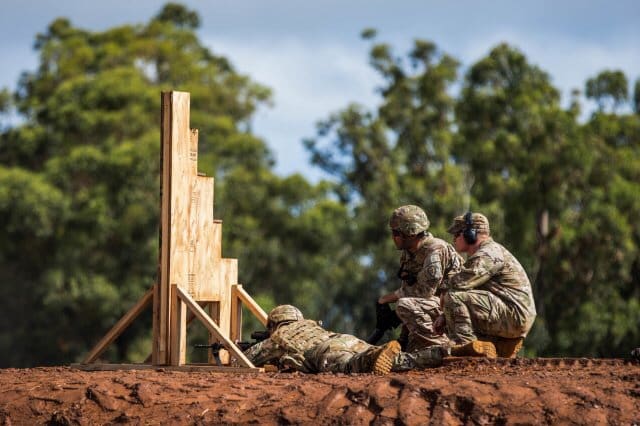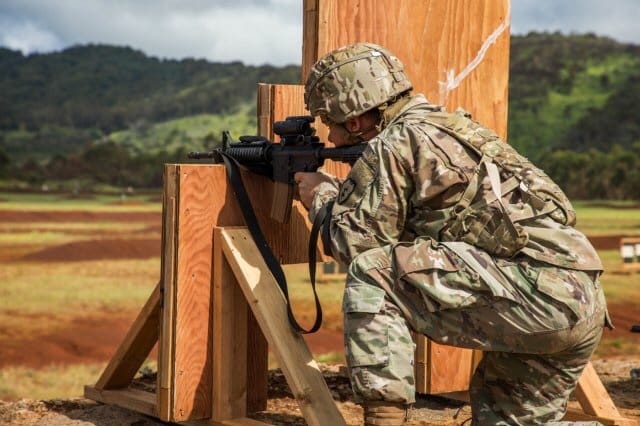SCHOFIELD BARRACKS, Hawaii — Similar to the implementation of the new Army Combat Fitness Test (ACFT), the Army is now changing how Soldiers qualify with their weapons, making individual weapons qualification more combat focused beginning October 2019.

Soldiers across the 25th Infantry Division with varying skill levels prepared for the new marksmanship standards by conducting a pilot program to assess current installation support capabilities at Schofield Barracks, Hawaii.
The new four-phase course will now feature standing firing positions. Soldiers are issued four 10-round magazines to engage 40 pop-up targets from the four shooting positions. Soldiers start in the standing position then go to the prone unsupported, then prone supported, kneeling supported and finally the standing supported position. Soldiers utilize a barricade and will have 8-10 second intervals to change magazine and positions.

The new course will replace the current marksmanship qualification course with one that requires Soldiers to engage targets faster and to operate as they would during an enemy engagement.

“The old qualification did not help in combat situations, so they incorporated magazine exchanges and position changes by yourself to represent combat,” said Staff Sgt. Tadeysz Showers, assigned to the 25th Sustainment Brigade. “No matter the military occupational specialty (MOS), any MOS can teach a Soldier how to do this new weapons qualification.”

The division marksmanship pilot program was led by the Lightning Academy Senior Instructor Staff Sgt. Daniel Martin and three other instructors through preliminary marksmanship instruction (PMI), Engagement Skills Trainer (EST), and qualification tables on a standard pop-up range.

In the current qualification course, Soldiers take instructions from the range tower, such as when to change magazines and firing positions. “Now, the qualification only has commands to begin the qualification and when it has ended,” said Martin. “The four 10-round magazines will be in your kit, and you will transition your position and conduct magazine changes on your own without any commands from the tower.”
“The new qualification saves time,” said Showers. “The old qualification took about 20 minutes, this one takes about four minutes to execute and is much faster paced.”

The course is set to become the Army-wide standard for rifle marksmanship. Qualification implementation begins October 2019.
“The new qualification is more challenging, but a lot more realistic,” said Martin. “Some Soldiers have never conducted magazine exchanges on their own without being told when to on the line during the Automatic Record Fire. The course is helping the Army become more efficient in urban combat scenarios.”
“Soldiers start by receiving a series of classes on how to properly zero the rifle, whether it’s a bare rifle or with optics,” said Showers. “Soldiers received classes on laser bore sight, Minute of Angle (MOA), zeroing process, windage, ballistics, and also received EST training and practiced position changes before going to a live range.”

The new weapons qualification maintains the same score requirements as the current system to pass in each category; Soldiers must hit 23 targets out of 40 to qualify. Soldiers must hit 23 to 29 targets for a Marksman rating, 30 to 35 for Sharpshooter and 36 to 40 to qualify for Expert.
“This new weapons qualification is more combat oriented with changing positions, changing magazines and engaging the targets,” said Sgt. Octavius Moon assigned to the 25th Sustainment Brigade. “This will help Soldiers shoot better as well as make ranges faster and have more Soldiers qualified. It helps Soldiers become more knowledgeable about their weapon as well.”
By SGT Sarah Sangster


This is all well and good if your Infantry. But for non-combat arms support units good luck trying to get anytime on a weapons range to actually do any of this. You’re lucky if you even touch your weapon every 6 months.
Serious question: Why wasn’t combat-focussed marksmanship always used? I can understand basic fundamental weapon use/manipulation and basic shooting techniques as a first phase, but then why would this not have always been used after that?
Biased Army research that started with a foregone conclusion, and then did the “research” to arrive at the desired conclusion resulted in “TRAINFIRE” and for 64 years, that’s what the Army did, and built installations to support. We’ve now got 64 years worth of culture, 64 years worth of policy, 64 years of institutional memory, 64 years worth of range design and construction pointing towards TRAINFIRE, and the Army just went hard right with the training doctrine. Expect some mishaps, a lot of failure, and in the end maybe in three years time, a better shooting Army. The article is cute, but I’d like to see the training management docs, the written test results, the qualification rates by type. I bet they just got their asses kicked. That’s a good thing though. This strategy pays well for those units willing to put in a SOLID 4.5 pays of QUALITY training before any rounds are fired. Those units looking for a “quick PMI” will see their just rewards. Don’t take short cuts, STUDY the .9, the .35 and the .40. There’s over 800 pages there, anybody breezing through this is in for a shit show
4.5 *DAYS
I remember when I first fired the M16A2 in the Army in 1986 and 1987 at Ft. Benning, it was a big change from the M16A1 that we had been using for years. I remember they gave us the M16A2 off a rack at Ft. Benning to qualify and thought this was not an M16A1. They did not instruct us on the differences with the between the weapons much. The biggest difference was the new electronic range with moving Soviet green uniformed soldiers. The target soldiers moved at different angles at close range. We were not used to shooting moving targets at close range like this. I went from Expert to Sharpshooter for qualification. I guess the did not institute this range setup Army wide because of the cost of the range and maintenance. At least soldiers are getting the training they need for the new qualifications. It will really improve things for them in the long run.
Biased Army research in 1955 that started with a foregone conclusion, and then did the “research” to arrive at the desired conclusion resulted in “TRAINFIRE.” For 64 years, that’s what the Army did, and built installations to support.
We’ve now got 64 years worth of culture, 64 years worth of policy & Army wide and local SOPs, 64 years of institutional memory, 64 years worth of range design and construction pointing towards TRAINFIRE, and the Army just went hard right with the training doctrine.
Expect some mishaps, a lot of failure, and in the end maybe in three years time, a better shooting Army.
The article is cute, but I’d like to see the training management docs, the written test results, the qualification rates by type. I bet they just got an epiphany. That’s a good thing though. This strategy pays well for those units willing to put in a SOLID 4.5 days of QUALITY training before any rounds are fired, if the goal is quality. Those units looking for a “quick PMI” will earn their just rewards.
Don’t take short cuts, STUDY the .9, the .35 and the .40. There’s over 800 pages there, leaders breezing through this are in for a S. show.
There will be much weeping and gnashing of teeth. I really hope units get a wake up call before this goes live. I’m tracking there’s an MTT, but I just don’t see support units (and some maneuver units) giving their soldiers enough time behind the gun until they see the results of the first iteration. I think it’s a good thing overall, I just hope leadership can wrap their heads around what this all entails.
Between the new ACFT for physical fitness assessment and the new marksmanship qualification test, a lot of the QTB stats driven Six Sigma perversion assessment is going to go haywire. Will it eventually produce a better Army? Sure. But there’s going to be tremendous incentive to pad stats and cheat at the Company and Battalion levels as an entire generation of commanders who get racked and stacked by 2 point differences in APFT averages or marksmanship scores. There will be ‘rent seeking behavior’ that will require serious oversight at the Installation and senior leadership levels. There has to be a near “Year-Zero” mindset shift that gets condoned by leadership.
THIS. This could be a serious moment to confront the Integrity / Moral Courage Gap that has been bred into the Career(-ist) mid- to senior- leadership by a single minded
and false pursuit of “metrics” as a be-all, end-all.
It won’t. Just like steroids in sports, the bad cheaters will get caught and the good cheaters will rise to the top. When there is all the incentive to cheat and either none or a negative incentive not too, guess what a majority of commanders will do?
Its not only the live fire potion that imparts the skill. The more critical piece of this strategy is the 4.5 Days of prepatory training before a single shot is fired.
Units that dont seriously STUDY the TCs and execute careful, well thought out training plans will get WRECKED on the ranges, and in the ammunition management. Leaders that don’t put in the preparation will skyline across a backdrop of failure.
The adoption of this new training strategy, will put an end to the fantasy that every Army NCO is a marksmanship trainer. That’s never been true.
Australia has run this for about 2 years now. An obvious thing to do. Still kept a degree of the old marksmanship stuff, but this is far more useful to see who can actually get into the headspace. It’s a stress test more than a shooting test.
Fun as hell.
Wait till you see the LSW version.